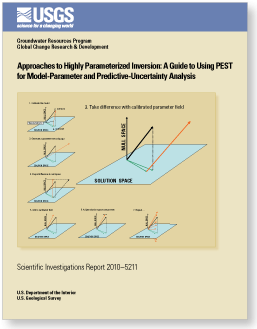Scientific Investigations Report 2010–5211

AbstractAnalysis of the uncertainty associated with parameters used by a numerical model, and with predictions that depend on those parameters, is fundamental to the use of modeling in support of decisionmaking. Unfortunately, predictive uncertainty analysis with regard to models can be very computationally demanding, due in part to complex constraints on parameters that arise from expert knowledge of system properties on the one hand (knowledge constraints) and from the necessity for the model parameters to assume values that allow the model to reproduce historical system behavior on the other hand (calibration constraints). Enforcement of knowledge and calibration constraints on parameters used by a model does not eliminate the uncertainty in those parameters. In fact, in many cases, enforcement of calibration constraints simply reduces the uncertainties associated with a number of broad-scale combinations of model parameters that collectively describe spatially averaged system properties. The uncertainties associated with other combinations of parameters, especially those that pertain to small-scale parameter heterogeneity, may not be reduced through the calibration process. To the extent that a prediction depends on system-property detail, its postcalibration variability may be reduced very little, if at all, by applying calibration constraints; knowledge constraints remain the only limits on the variability of predictions that depend on such detail. Regrettably, in many common modeling applications, these constraints are weak. Though the PEST software suite was initially developed as a tool for model calibration, recent developments have focused on the evaluation of model-parameter and predictive uncertainty. As a complement to functionality that it provides for highly parameterized inversion (calibration) by means of formal mathematical regularization techniques, the PEST suite provides utilities for linear and nonlinear error-variance and uncertainty analysis in these highly parameterized modeling contexts. Availability of these utilities is particularly important because, in many cases, a significant proportion of the uncertainty associated with model parameters—and the predictions that depend on them—arises from differences between the complex properties of the real world and the simplified representation of those properties that is expressed by the calibrated model. This report is intended to guide intermediate to advanced modelers in the use of capabilities available with the PEST suite of programs for evaluating model predictive error and uncertainty. A brief theoretical background is presented on sources of parameter and predictive uncertainty and on the means for evaluating this uncertainty. Applications of PEST tools are then discussed for overdetermined and underdetermined problems, both linear and nonlinear. PEST tools for calculating contributions to model predictive uncertainty, as well as optimization of data acquisition for reducing parameter and predictive uncertainty, are presented. The appendixes list the relevant PEST variables, files, and utilities required for the analyses described in the document. |
Posted September 6, 2011 For additional information contact: Part or all of this report is presented in Portable Document Format (PDF); the latest version of Adobe Reader or similar software is required to view it. Download the latest version of Adobe Reader, free of charge. |
Doherty, J.E., Hunt, R.J., and Tonkin, M.J., 2010, Approaches to highly parameterized inversion: A guide to using PEST for model-parameter and predictive-uncertainty analysis: U.S. Geological Survey Scientific Investigations Report 2010–5211, 71 p., available at http://pubs.usgs.gov/sir/2010/5211.
Abstract
Introduction
Purpose and Scope
Summary and Background of Underlying Theory
Uncertainty Analysis for Overdetermined Systems
Linear Analysis for Underdetermined Systems
Non-linear Analysis for Underdetermined Systems
Uses and Limitations of Model Uncertainty Estimates
References
Appendix 1. Basic PEST Input
Appendix 2. PEST Utilities
Appendix 3. Groundwater Data Utilities
Appendix 4. Background and Theory of PEST Uncertainty Analyses